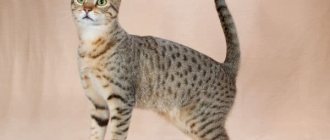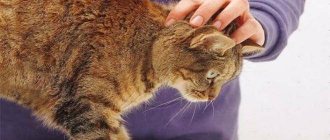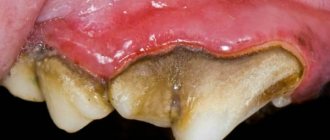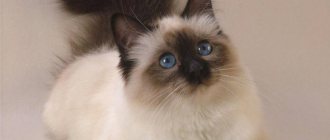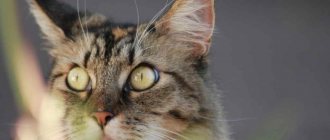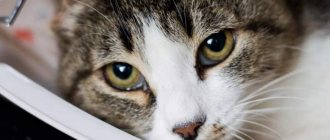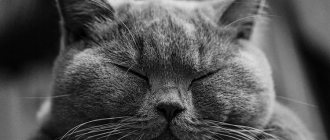History of the origin of the breed
Perhaps it’s worth starting with the fact that the Cymric and Manx breeds are closest relatives with a rich history, which they share between them. Tailless cats have been found on the Isle of Man for over 400 years. They have almost become a tourist attraction; they even mint coins with their image. It is believed that cats “with a flaw” were brought to the British Isles from the Far East by sailors in the 16th century. Over time, their population increased significantly, the cats changed somewhat, but their characteristic feature remained unchanged - the absence of a tail. The breed was named Menx. As for Cymric, it is not so famous and popular, since it was officially recognized only in the 60-70s of the last century.
In the middle of the last century, along with the short-haired Manx, their long-haired variety began to be exhibited. These cats took part in many exhibitions and were noticed by Canadian breeders, especially Leslie Foltsake and Blay Welsh. They began to seek recognition of the new breed and granting it champion status. In 1976, the LovebunnyCatery organization allowed these cats to compete in the championship under their own name, Cymric. And by 1990, the breed was recognized by five more American associations.
The name of the breed, like the Manx, reflects its historical homeland: Wales
in Welsh "Cymru".
Cymric descended from Manx cats, so in appearance, character and even the genetics of the tail, they are very similar to each other. We can say that the Cymric breed was born naturally. Despite this, breeding it turned out to be quite difficult due to the lack of targeted selection work in the early stages of creating the breed and the genetic anomalies that the tailless gene entails.
Video: Cymrik kitten
Nature of Shorttails
Mentions of this breed date back to the end of the 18th century. The Isle of Man is very small and none of the cats that lived on it in those days had a long enough tail. Almost all pets were tailless.
During the evolution of the breed, the tail remained short, and the coat remained thick and long. It's all about the climate. Not to say that it is very harsh, but the undercoat was very useful for these cats in the cold season.
Everyone is used to seeing dark gray, “marbled” and silver-gray cats of this breed. But there are also red Cymrics, as well as cream colored ones. They are very beautiful. In addition, they have a very learned appearance and are calm.
You can admire a photo of the Cymrik cat below. The most striking varieties of colors with characteristics characteristic of the breed are presented.
Breed description and standards
Cymrik is a tailless breed of long-haired cats that are externally distinguished by their strong build and rounded head shape with well-defined cheeks. They are strong and active with beautiful, clear eyes and a gorgeous shiny coat. The cats are medium in size, but due to their slender build they are much heavier than they might seem
Kymrik develops quite slowly; it can reach its full size, as well as the brightness of its color and eye color, only by the age of 5.
Head and muzzle
The head is rounded with well-protruding cheeks, slightly less wide than long. The forehead is rounded. The vibrissae pads are well defined. In profile, a slight depression should be noticeable on the nose. The ears are wide at the base with rounded tips, and may have a brush. Planted far apart and sloping outwards. The eyes are large, wide open, set slightly askew. The eye color should match the coat color.
Body type
The Cymric has a fairly wide chest and strong forelimbs. The shape of the short back is more like an arc that stretches from the shoulders to the back. The thighs are muscular and round with a low groin line. The limbs of the Cymric have a heavy build. The front legs are short and widely spaced, thanks to which the roundness of the chest is beautifully outlined. The hind legs are longer with heavy shins. The length of the hind limbs raises the croup, which outwardly looks as if the cat is always ready to jump. If you look at the hind legs from behind, they are straight. The paws are strong and rounded.
Types of Cymric tails
The fact that Cymrics are tailless cats does not mean that they cannot have a tail at all. There are both “stubs” and full-fledged tails. Depending on the length, they are called differently:
- Dimple rumpy - the tail is completely absent. There is a depression at the back of the spinal column, that is, where the tail begins in other breeds. A minimal protrusion that is barely perceptible is allowed;
- Riser - a short tail of several vertebrae, often hidden under the fur;
- Stumpy - short tail (shorter than a regular cat's);
- Tailed or longy - normal length tail.
Coat
The main difference between the Cymric and the original Manx breed is its double, heavy and shiny coat of medium length. It is silky and soft to the touch and has a fine texture. The coat should always look shiny and healthy. Cats have lush sideburns, and their frill reaches to the shoulders, forming a beautiful bib on the chest. The length of the coat increases towards the back of the body and falls smoothly. At the same time, the hair on the belly, panties and frill is longer than the hair on the body. Tassels on the ears and small tufts of hair between the toes are desirable.
Color
The standard for Cymric allows all colors except chocolate, lavender, color point and their combination with white.
How much does it cost and where can I buy it?
The price for representatives of this breed starts from 23 thousand rubles (9.5 thousand UAH). The cost of a show-class kitten can reach 57 thousand rubles (23 thousand UAH) and depends on gender, pedigree and tail length.
The main problem is to find a Cymric cattery. Because even abroad this is quite a difficult task. There are no similar nurseries in Russia. In Moscow there is not even anywhere to buy more traditional shorthaired Manx.
The situation is similar in Ukraine and Belarus. There are no Kymrik or Manx nurseries operating either in Kyiv or Minsk.
If you are planning to buy Cymrica abroad, find out reviews about the seller. However, remember that you should not take a kitten under 6 months old. It is advisable to consult a veterinarian before purchasing and check the condition of the tail (fraudulent sellers may deliberately trim the cat’s tail).
Character
The ancestors of the Cymric were wonderful mousecatchers; modern cats have not lost these skills, along with independence and adaptability to different conditions. They can stand up for themselves and will defend their own territory, so at the slightest extraneous sounds, the cat will react quickly and may even show aggression.
With close people, the Cymrik will be affectionate and gentle. In his usual environment, he is a balanced and calm, moderately playful cat. Cymrik becomes very attached to the owner, will follow him around and show interest in household chores. The Cymrik kitten easily adapts to the surrounding conditions and easily tolerates moving or changing families, if necessary. Kymrik is equally well suited for both large families and single people.
As for intellectual abilities, the Cymric is not deprived of them. He quickly learns the rules of behavior, and if the owner wishes, he can even master a few tricks. The Cymric will also use his extraordinary mind for personal purposes, if necessary, learn to open doors or cabinets.
Playful and affectionate
The voice of a Cymric is practically inaudible to the average ear. These cats are not capable of shrill screaming at the top of their voices, demanding food or attention.
However, gentle, flexible creatures are very capricious. They don't like to be cuddled by children. The family member who brought them into the house becomes their owner. They are especially affectionate and friendly with him.
Even man’s most faithful friend, the shepherd dog, can envy the Cymric’s devotion. Kymrik is so attached to his owner that he can become depressed when separated from him for a long time.
Ultrasound of animals. Why is it made?- Where can I take veterinary courses and what are they for?
Akita Inu. What kind of breed is this and what are its characteristics?
Cymric kittens are playful and cute. Since childhood, these cats have shown one of their very interesting character traits and behavior. They hide their toys - balls, feathers, and are even capable of stealing pencils or other stationery items.
Another distinctive feature: these cats love to swim. If you teach your baby to do this from childhood, an adult pet will never give up water procedures.
Cats are bathed if necessary. For example, after a grand renovation in the house or an unsuccessful walk in the mud. But some breeders like to do this monthly to keep the animal's coat smooth, shiny and beautiful.
Veterinarians do not interfere with this decision. The main thing is that the cat doesn’t mind.
Maintenance and care
Kymrik adapts well to life in an apartment, but it is better if he has the opportunity to often walk outside and hunt in the grass, for example, for insects. During walks, these cats should be protected from jumping from heights. The peculiarities of the development of the hind limbs made the Cymric not the best poison dart frog, and they are often unable to perform the vaunted cat landing on four paws. Even their running is special; in appearance it strongly resembles that of a rabbit, that is, its running consists of wide jumps.
Cohabitation with other pets
With other pets, the Cymrik is more likely to remain neutral. Although it is worth saying that these cats often find a common language with friendly dog breeds and even play together. Small rodents, birds or fish living in the house are usually observed from the outside, but it is still better not to leave the predator and potential prey alone.
Difficulties of breeding
Difficulties in breeding are one of the reasons why Cymrik has not gained the popularity it deserves. A pair of absolutely tailless animals cannot have offspring; a genetic mutation leads to the death of embryos or the birth of non-viable kittens.
Completely tailless cats can only be crossed with tailed ones.
But it doesn't end there either. It is very difficult to choose a suitable pair for a Cymric, such that the kittens born from the union meet all breed standards. In addition to intrabreeding, crossing with Manx cats is allowed.
Care
At first glance, it may seem that cats' long hair requires daily brushing. But, with a properly balanced diet, Kymrik’s coat will always be neat, and it is enough to comb it 1-2 times a week, and you need to teach it to comb from an early age - adults may protest against such a procedure. Cats perfectly understand the purpose of a scratching post, and will never sharpen their claws on any other piece of furniture. But again, this is provided that the kitten is accustomed to it from a young age.
Who is Cymrik suitable for?
This breed has historically developed as a hunter. Kymrik will guard the house instead of the dog. A cat can even attack other people if it sees danger. In this regard, she does not like guests too much. He looks closely for a long time, calms down when he is convinced that there is no danger. The rest of the time she is lively, energetic, active, and friendly. The character is balanced and calm. He loves to help his owner and participates in everything that happens. Cats love to travel and tolerate travel well. Suitable for those who periodically change their place of residence or go on business trips. You can take Kymrik with you.
Cats love children and get along with other pets. But they suffer from excessive attention if children appear in the family when the cat is already an adult. Accustomed to a calm, quiet life, she cannot stand being dragged around or being squeezed. He loves to rest on his owner's lap and lie close to him when he sleeps.
Diet
Kimrik is not picky about food, but given the fact that feeding with industrial feed is common among large breeders, especially foreign ones, modern representatives of the breed are perfectly adapted to it and do not need natural nutrition. The activity of the Cymric must be maintained with a balanced, nutritious diet, and in order for the coat to be shiny, it is necessary to provide it with the necessary vitamins and microelements.
When choosing the optimal food, take into account the age category and physiological state of the animal (castration, lactation, pregnancy). In addition, it is important to pay attention to the labeling according to the level of energy consumption, which is individual for each animal (even of the same breed).
Reviews from owners of the Cymrik breed
You can leave your reviews about the Cymrik cat breed, other users will be interested: Victoria:
“It’s simply impossible to buy Cymric in Moscow. It’s not like you can’t find purebred mixtures. They brought me a cat from abroad. I really wanted a tailless creature. The cat is smart, understanding, affectionate is not the right word. He cuddles, climbs into his arms, and lays down in a ball next to him. He definitely wants to be where I am. Doesn't let me out of his sight for a moment. I feed her with special food. I try to buy quality ones. I sell kittens at a low price. There is no Cymric cat. The little ones also turn out beautiful and cute. Each time 1-2 kittens. There were cases when we had to euthanize.”
Health and life expectancy
Proper and balanced nutrition allows them to maintain excellent health and beautiful appearance. But the structural features of the spine and taillessness have left their mark, and in some cases entail various kinds of genetic abnormalities. Cymrics have inherited some hereditary diseases from other breeds.
- Coccyx atrophy in cats with partial tails;
- Progressive corneal dystrophy most often develops between the ages of 4 months and invariably leads to blindness;
- Manx syndrome involves a collection of birth defects that may include pathologies of the spine, urinary tract, intestines and, as a result, digestive problems. Unfortunately, this genetic abnormality affects about 20% of cats and appears from 4-5 months of age.
- This breed is more vulnerable to various types of neurological disorders.
Kymriks have been formed for a long time through natural selection, their immune system is quite strong, but this does not relieve owners from the need to carry out planned veterinary preventive measures. Life expectancy is 8-14 years.
Diseases of the cat breed
The sore spot of Cymric is the spine. Due to a gene mutation that causes these cats to be born tailless, pets can develop Manx syndrome. Cymric kittens that inherit the tail-less gene from both parents usually die before birth. And those who are born with the “defective” gene may be born with bowel problems, bladder problems, and spina bifida.
If the kitten has successfully grown to 6 months, then it will be a strong, healthy pet. Therefore, they usually begin to be sold at the age of 6-7 months.
Choice of kitten and price
Finding Cymrik kittens is quite problematic, because they are rare not only in Russia and neighboring countries, but in the rest of the world. In the USA, nurseries set prices individually for each kitten; on average, they range from $200-400.
When choosing such an unusual and expensive kitten, you should be very careful. There is a possibility that the taillessness is the result of injury or amputation, and the seller is a common scammer. It should also be understood that the cost of a good Cymric cannot be symbolic, and the pedigree must be recorded at least up to the fifth generation.
If kittens are born with a long tail, then breeders can dock it in order to quickly find new owners for the babies.
Considering the possibility of manifestation of Manx syndrome in kittens aged 4 months and older, they are in no hurry to take babies home before six months of age, and without making sure that the baby is healthy and does not have a developmental pathology.
Four types of Cymric tailless cats
Since in one litter there may be kittens not only with long and short hair, but also with different tails, they are divided into the following types based on the latter characteristic
Rumpy
The name comes from the English word rumpy. These animals are distinguished by the complete absence of a tail, sometimes there is even a depression in its place.
For this reason, rampies are rated highest in the show and breed class. They are the ones who most often win prizes at felinological exhibitions.
Rampy riser
Rumpy-risers have a short appendage instead of a tail. It consists of three or four vertebrae covered with hair.
A sign that such a cat is allowed to compete is the length of the growth.
If, in a standing position, the modified tail does not reach the hand when stroking the animal on the back, admission is allowed.
Stumpy
This type of Cymric has a short tail, usually with defects - knots and creases. Such animals are suitable only as pets; they are not allowed for show or breeding.
Longs
Longi has a tail of normal length. If it is free of defects, then the pet is often used in the breeding program.
If there are knots and kinks, breeders dock the tail within a week of birth and sell the cat as a pet. Such animals are not allowed to participate in exhibitions.
Photos
Photos of Cymric cats:
Color
The following photos show what Cymrik looks like
Cymrik can come in different colors and patterns. The CFA organization standards include the following colors:
- white with blue eyes,
- white with copper eyes,
- white with different colored eyes,
- blue,
- black,
- ginger,
- cream,
- silver chinchilla color,
- silver-smoky,
- black/blue haze,
- silver/blue/red/brown tabby/mackerel,
- cake,
- creamy white,
- bicolors,
- tabby with white spots.
Chocolate, lavender and Himalayan colors (including those with white spots) are considered deviations from the standard.
Some more photos and pictures are collected in the video:
Features of the breed
Representatives of this breed are very fond of heights, so if living space allows, it is recommended to install a play complex with high stands. But Cymrics can easily ignore ordinary toys.
These animals love walks, provided that the outside world has been familiar to them since childhood. You can no longer train an adult cat to perform such procedures. Remember that the main thing is safety. When leaving home, do not open the windows; the animal may get stuck or die.
Feeding
High-quality nutrition is the key to the health and longevity of any cat. Kymrik needs to choose a low-calorie menu with a high content of protein and microelements. From ready-made commercial feeds, holistic drying is suitable, but it is better to create an individual diet from a veterinarian.
Necessary care
Cymric cats need to be brushed regularly due to their thick fur. It is best to get a whole set of combs and a slicker brush. Although these cats themselves are clean, combing by a person will prevent the formation of tangles. In autumn and spring, the animal will have to be combed every day. Be sure to purchase a nail clipper. Even if you have a scratching post at home, your cat must have a manicure. Also remember to clean your ears every week.
Cymric diseases
As noted above, this breed is very difficult to breed. The standard, the absence of a tail, brings with it certain problems. Because of this, there are so few representatives of the breed that relatives have to be crossed, and this results in kittens with physical defects. The mutant gene is recessive, so its carrier can be an individual with a tail. For the offspring to be healthy, one of the parents must not have this gene at all. If this rule is violated, in 95% of cases the offspring is born dead.
Even with thoughtful mating, a quarter of kittens die in the early stages of pregnancy. Some kittens, even if they look quite healthy on the outside, have Manx syndrome, which is a disorder of the structure of the spine. If such a deviation is detected, the kittens are euthanized. The syndrome can occur in any kitten up to six months old, so ask the seller for documents confirming the health of the pet. Mans syndrome is a side effect of a mutation that is always fatal. It does not depend in any way on heredity.
